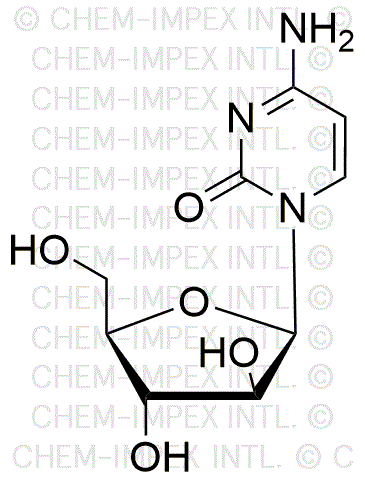Cytosine 1-b-D-arabinofuranoside is widely utilized in research focused on:
- Antiviral Research: This compound is used in the development of antiviral medications, particularly for treating viral infections like herpes simplex virus. Its ability to inhibit viral replication makes it a valuable tool for researchers.
- Oncology: It plays a role in cancer research, specifically in the study of nucleoside analogs that can be used in chemotherapy. Its effectiveness in disrupting cancer cell proliferation is being explored in various studies.
- Genetic Studies: Researchers utilize this compound in molecular biology to study DNA and RNA synthesis, providing insights into genetic expression and regulation. This is crucial for understanding genetic disorders and developing gene therapies.
- Pharmaceutical Formulations: It is incorporated into drug formulations to enhance bioavailability and efficacy. Its unique structure allows for improved absorption in the body, making it a preferred choice in certain therapeutic applications.
- Biotechnology: In the field of biotechnology, it is used in the synthesis of modified nucleotides for various applications, including the development of diagnostic tools and therapeutic agents that target specific diseases.
General Information
Properties
Safety and Regulations
Applications
Cytosine 1-b-D-arabinofuranoside is widely utilized in research focused on:
- Antiviral Research: This compound is used in the development of antiviral medications, particularly for treating viral infections like herpes simplex virus. Its ability to inhibit viral replication makes it a valuable tool for researchers.
- Oncology: It plays a role in cancer research, specifically in the study of nucleoside analogs that can be used in chemotherapy. Its effectiveness in disrupting cancer cell proliferation is being explored in various studies.
- Genetic Studies: Researchers utilize this compound in molecular biology to study DNA and RNA synthesis, providing insights into genetic expression and regulation. This is crucial for understanding genetic disorders and developing gene therapies.
- Pharmaceutical Formulations: It is incorporated into drug formulations to enhance bioavailability and efficacy. Its unique structure allows for improved absorption in the body, making it a preferred choice in certain therapeutic applications.
- Biotechnology: In the field of biotechnology, it is used in the synthesis of modified nucleotides for various applications, including the development of diagnostic tools and therapeutic agents that target specific diseases.
Documents
Safety Data Sheets (SDS)
The SDS provides comprehensive safety information on handling, storage, and disposal of the product.
Product Specification (PS)
The PS provides a comprehensive breakdown of the product’s properties, including chemical composition, physical state, purity, and storage requirements. It also details acceptable quality ranges and the product's intended applications.
Certificates of Analysis (COA)
Search for Certificates of Analysis (COA) by entering the products Lot Number. Lot and Batch Numbers can be found on a product’s label following the words ‘Lot’ or ‘Batch’.
*Catalog Number
*Lot Number
Certificates Of Origin (COO)
This COO confirms the country where the product was manufactured, and also details the materials and components used in it and whether it is derived from natural, synthetic, or other specific sources. This certificate may be required for customs, trade, and regulatory compliance.
*Catalog Number
*Lot Number
Safety Data Sheets (SDS)
The SDS provides comprehensive safety information on handling, storage, and disposal of the product.
DownloadProduct Specification (PS)
The PS provides a comprehensive breakdown of the product’s properties, including chemical composition, physical state, purity, and storage requirements. It also details acceptable quality ranges and the product's intended applications.
DownloadCertificates of Analysis (COA)
Search for Certificates of Analysis (COA) by entering the products Lot Number. Lot and Batch Numbers can be found on a product’s label following the words ‘Lot’ or ‘Batch’.
*Catalog Number
*Lot Number
Certificates Of Origin (COO)
This COO confirms the country where the product was manufactured, and also details the materials and components used in it and whether it is derived from natural, synthetic, or other specific sources. This certificate may be required for customs, trade, and regulatory compliance.


